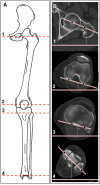Intra-individual variance of bilateral femoro-tibial leg rotation: a CT study of 105 healthy subjects
- PMID: 32556434
- PMCID: PMC7973925
- DOI: 10.1007/s00167-020-06101-6
Intra-individual variance of bilateral femoro-tibial leg rotation: a CT study of 105 healthy subjects
Abstract
Purpose: In cases of suspected rotational deformity of the lower limb, in particular in post-traumatic malalignment following closed nailing, there is a lack of adequate reference values. Available publications on leg rotation have either small sample sizes or do not include bilateral or whole leg rotation of healthy legs. This study aimed to determine side-specific reference values of lower limb rotation in a large healthy sample. This may be helpful in acute clinical settings as well as for medical expert opinion.
Methods: 226 consecutive bilateral lower limb computed tomography (CT) angiographies were screened. 105 patients (210 legs) were included (40 females, 65 males, mean age 67 ± 12 years). Bilateral axial femoral and tibial rotation alignment were independently measured and overall leg rotation was computed by two methods. Distributions, sex, and side differences were analyzed.
Results: Two-sided paired t tests showed significant differences between right and left for all measurements. The left side showed a more pronounced mean anteversion in the femur of 2.2° (p = 0.002) and the right side higher mean external rotation in the tibia of 2.8° (p < 0.001). Overall leg rotation showed 5.1° more mean external rotation on the right side (p < 0.001) with both methods. Absolute side-to-side whole leg rotation difference was 9.5°. Absolute differences between both methods were 3.3°. The variance was high. 23 femora were retroverted, 1 tibia internally rotated, and 9 legs were overall internally rotated. No variables differed between female and male subjects except for femoral version (right p = 0.003 and left p = 0.002). Correlation coefficients were high (rho 0.550-0.934, all p < 0.001).
Conclusion: There is a significant prevalence of side-to-side asymmetry in femoro-tibial torsion. Although side-to-side differences are not extraordinary, comparative axial femoro-tibial rotation alignment should always be interpreted with caution.
Level of evidence: Diagnostic, retrospective cohort study, level III.
Conflict of interest statement
CKB is employee of Smith and Nephew GmbH. All named authors hereby declare that they have no conflicts of interest to disclose.
Figures



References
-
- Auston DA, Meiss J, Serrano R, Sellers T, Carlson G, Hoggard T, et al. Percutaneous or open reduction of closed tibial shaft fractures during intramedullary nailing does not increase wound complications, infection or nonunion rates. J Orthop Trauma. 2017;31(4):215–219. doi: 10.1097/BOT.0000000000000777. - DOI - PubMed
-
- Clementz BG. Assessment of tibial torsion and rotational deformity with a new fluoroscopic technique. Clin Orthop Relat Res. 1989;245:199–209. - PubMed
-
- Fabry G, Cheng LX, Molenaers G. Normal and abnormal torsional development in children. Clin Orthop Relat Res. 1994;302:22–26. - PubMed
MeSH terms
LinkOut - more resources
Full Text Sources
Medical
Research Materials

